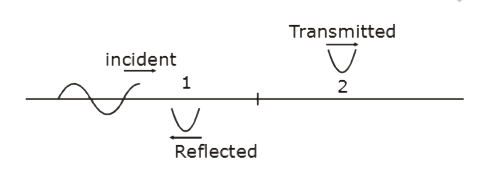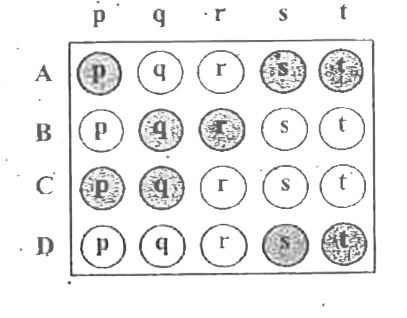In the shown figure answer the following two questions

If Pi,PrandPt are powers of incident, reflected and transmitted waves and Ii,It the corresponding intensities, then
Pi=Pr+Pt
Ii=Ir+It
both (a) and (b) are correct
both (a) and (b) are wrong
The correct Answer is:A
Step by step video & image solution for In the shown figure answer the following two questions If P_i , P_r and P_t are powers of incident, reflected and transmitted waves and I_i, I_t the corresponding intensities, then by Physics experts to help you in doubts & scoring excellent marks in Class 12 exams.
Updated on:21/07/2023Topper's Solved these Questions
- WAVESBOOK - MOTIONCHAPTER - WAVESEXERCISE - EXERCISE -2 (Level -II) (Multiple correct JEE Advanced)
14 Videos
- WAVESBOOK - MOTIONCHAPTER - WAVESEXERCISE - EXERCISE -3 (Level -I) (Subjective JEE Advanced)
15 Videos
- WAVESBOOK - MOTIONCHAPTER - WAVESEXERCISE - EXERCISE -1 (Objective Problems JEE Main)
35 Videos
- WAVE OPTICS BOOK - MOTIONCHAPTER - WAVE OPTICS EXERCISE - EXERCISE - 4 (Level - II) Previous Year | JEE Main
16 Videos
- WORK, POWER & ENERGY BOOK - MOTIONCHAPTER - WORK, POWER & ENERGY EXERCISE - Exercise - 3 Section-B
22 Videos
Similar Questions
In the following questions, select the missing term.
F,I,M,P,T,?
View SolutionA harmonic wave is travelling on string 1. At a junction with string 2 it is partly reflected and partly transmitted. The linear mass density of the second string is four times that of the first string, and that the boundary between the two strings is at x=0. If the expression for the incident wave is
yi=Aicos(k1x−ω1t)
(a) What are the expressions for the transmitted and the reflected waves in terms of Ai,k1 and ω1?
(b) Show that the average power carried by the incident wave is equal to the sum of the average power carried by the transmitted and reflected waves.
View Solution
Knowledge Check
In the shown figure answer the following two question.

If Pi,Pr,Pt are powers of incident, reflected and transmitted waves and Ii,Ir,It the corresponding intensities , thenAPi=Pr+PtBIi=Ir+ItCboth( a) and (b) are correctDboth ( a) and (b) are wrongA travelling wave is partly reflected and partly transmitted from a rigid boundary. Let ai,arandat be the amplitude of incident wave, reflected wave and transmitted wave and Ii,IrandIt be the corresponding intensities. Then choose the correct alternatives.
AIiIr=(aiar)2BIiIt=(aiar)2CIrIt=(arat)2DAll the aboveDIRECTIONS: Study the following information and answer the questions given :
P, Q, R, S, T and U are sitting along the circle facing the centre.
(i) P is immediate neighbour of Q who is second to the right of R.
(ii) S is second to the left of T.
(iii) U is immediate neighbour of T.
What is the position of U ?ABetween T and RBSecond to the right of RCImmediate right of QDTo the immediate right of S
A harmonic wave is travelling on string 1. At a junction with string 2 it is partly reflected and partly transmitted . The linear mass density of the second string is four times that of the first string , and that the boundary between the two strings is at x=0 . If the expression for the incident wave is yi=Aicos(k1x−ω1t).
What are the expressions for the transmitted and the reflected waves in terms of Ai,K1andω1?
(b) Show that the average power by the incident wave is equal to the sum of the average power carried by the transmitted and reflected waves .
View SolutionThe section contains one question. Each question contains statements given in two columns which have to be matched . The statements in Column I are labelled A, B, C and D , while the statements in Column II are labelled p,q, r, s and t. Any given statement in Column I can have correct matching with ONE OR MORE statements (s) in Column II . The appropriate bubbles corresponding to the answers to these questions have to be darkened as illustrated in the following example:
If the correct matches are A-p, s and t, B-q and r, C-p and q, and D-s and t, then the correct darkening of bubbles will look like the following .

Match the following :

View SolutionIn the previous question if l=662, P=2000, and T=3, then find the value of R.
View SolutionTwo parallel beams of light P and Q are incident normally on a prism and the transmitted rays are brought to focus with the help of a convergent lens as shown in Fig. 2.23. If the intensities of the upper and lower beams immediately after transmission from face AC are 4I abd I, respectively, find the resultant intensity at the focus.
View SolutionEach of the questions below consists of a question and two statements numbered I and II given below it. You have to decide whether the data provided in the statements are sufficient to answer the question. Read both the statements and give answer
1) if the data in statement I alone are sufficient to answer the question while the data in statement II alone are not sufficient to answer the question.
2) if the data in statement II alone are sufficient to answer the question while the data in statement I alone are not sufficient to answer the question.
3) if the data either in statement I alone or in statement II alone are sufficient to answer the question.
4) if the data even in both statements I and II together are not sufficient to answer the question.
5) if the data in both statements I and II together are necessary to answer the question.
Who is the shortest among P, Q, R, S and T?
I. Q is taller than T but shorter than S and R.
II. P is not the shortest.
View Solution
